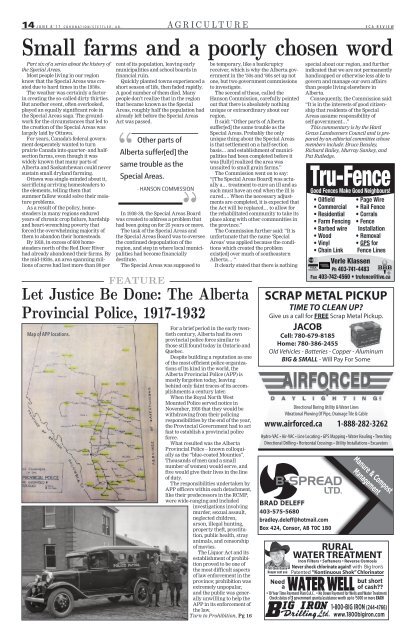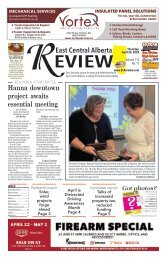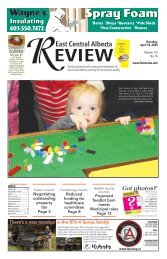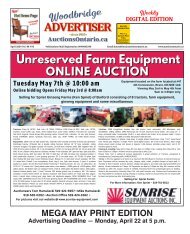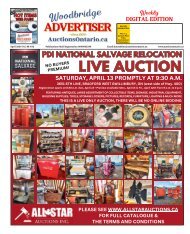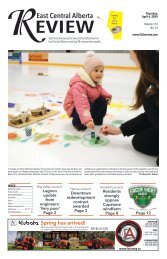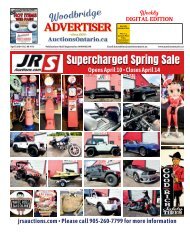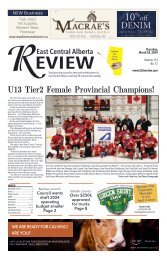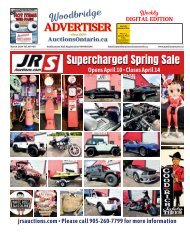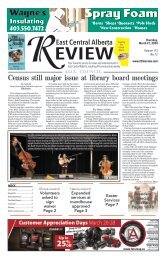June8
You also want an ePaper? Increase the reach of your titles
YUMPU automatically turns print PDFs into web optimized ePapers that Google loves.
14 J u n e 8 ' 1 7 C o r o n a t i o n / S t e t t l e r , A b . A g r i c u l t u r e<br />
E C A r e v i e w<br />
Small farms and a poorly chosen word<br />
Part six of a series about the history of<br />
the Special Areas.<br />
Most people living in our region<br />
know that the Special Areas was created<br />
due to hard times in the 1930s.<br />
The weather was certainly a factor<br />
in creating the so-called dirty thirties.<br />
But another event, often overlooked,<br />
played an equally significant role in<br />
the Special Areas saga. The groundwork<br />
for the circumstances that led to<br />
the creation of the Special Areas was<br />
largely laid by Ottawa.<br />
For years, Canada’s federal government<br />
desperately wanted to turn<br />
prairie Canada into quarter- and halfsection<br />
farms, even though it was<br />
widely known that many parts of<br />
Alberta and Saskatchewan could never<br />
sustain small dryland farming.<br />
Ottawa was single-minded about it,<br />
sacrificing arriving homesteaders to<br />
the elements, telling them that<br />
summer fallow would solve their moisture<br />
problems.<br />
As a result of the policy, homesteaders<br />
in many regions endured<br />
years of chronic crop failure, hardship<br />
and heart-wrenching poverty that<br />
forced the overwhelming majority of<br />
them to abandon their homesteads.<br />
By 1918, in excess of 600 homesteaders<br />
north of the Red Deer River<br />
had already abandoned their farms. By<br />
the mid-1920s, an area spanning millions<br />
of acres had lost more than 80 per<br />
<br />
cent of its population, leaving early<br />
municipalities and school boards in<br />
financial ruin.<br />
Quickly planted towns experienced a<br />
short season of life, then faded rapidly.<br />
A good number of them died. Many<br />
people don’t realize that in the region<br />
that became known as the Special<br />
Areas, roughly half the population had<br />
already left before the Special Areas<br />
Act was passed.<br />
“<br />
Other parts of<br />
Alberta suffer[ed] the<br />
same trouble as the<br />
Special Areas.<br />
- HANSON COMMISSION<br />
In 1938-39, the Special Areas Board<br />
was created to address a problem that<br />
had been going on for 25 years or more.<br />
The task of the Special Areas and<br />
the Special Areas Board was to oversee<br />
the continued depopulation of the<br />
region, and step in where local municipalities<br />
had become financially<br />
destitute.<br />
The Special Areas was supposed to<br />
Let Justice Be Done: The Alberta<br />
Provincial Police, 1917-1932<br />
Map of APP locations.<br />
FEATURE<br />
“<br />
For a brief period in the early twentieth<br />
century, Alberta had its own<br />
provincial police force similar to<br />
those still found today in Ontario and<br />
Quebec.<br />
Despite building a reputation as one<br />
of the most efficient police organizations<br />
of its kind in the world, the<br />
Alberta Provincial Police (APP) is<br />
mostly forgotten today, leaving<br />
behind only faint traces of its accomplishments<br />
a century later.<br />
When the Royal North West<br />
Mounted Police served notice in<br />
November, 1916 that they would be<br />
withdrawing from their policing<br />
responsibilities by the end of the year,<br />
the Provincial Government had to act<br />
fast to establish a provincial police<br />
force.<br />
What resulted was the Alberta<br />
Provincial Police – known colloquially<br />
as the “blue-coated Mounties”.<br />
Thousands of men (and a small<br />
number of women) would serve, and<br />
five would give their lives in the line<br />
of duty.<br />
The responsibilities undertaken by<br />
APP officers within each detachment,<br />
like their predecessors in the RCMP,<br />
were wide-ranging and included<br />
investigations involving<br />
murder, sexual assault,<br />
neglected children,<br />
arson, illegal hunting,<br />
property theft, prostitution,<br />
public health, stray<br />
animals, and censorship<br />
of movies.<br />
The Liquor Act and its<br />
establishment of prohibition<br />
proved to be one of<br />
the most difficult aspects<br />
of law enforcement in the<br />
province; prohibition was<br />
extremely unpopular,<br />
and the public was generally<br />
unwilling to help the<br />
APP in its enforcement of<br />
the law.<br />
Turn to Prohibition, Pg 16<br />
be temporary, like a bankruptcy<br />
receiver, which is why the Alberta government<br />
in the ‘50s and ‘60s set up not<br />
one, but two government commissions<br />
to investigate.<br />
The second of these, called the<br />
Hanson Commission, carefully pointed<br />
out that there is absolutely nothing<br />
unique or extraordinary about our<br />
region.<br />
It said: “Other parts of Alberta<br />
suffer[ed] the same trouble as the<br />
Special Areas. Probably the only<br />
unique thing about the Special Areas<br />
is that settlement on a half-section<br />
basis… and establishment of municipalities<br />
had been completed before it<br />
was [fully] realized the area was<br />
unsuited to small grain farms.”<br />
The Commission went on to say:<br />
“[The Special Areas Board] was actually<br />
a… treatment to cure an ill and as<br />
such must have an end when the ill is<br />
cured…. When the necessary adjustments<br />
are completed, it is expected that<br />
the Act will be replaced… to allow for<br />
the rehabilitated community to take its<br />
place along with other communities in<br />
the province.”<br />
The Commission further said: “It is<br />
unfortunate that the name ‘Special<br />
Areas’ was applied because the conditions<br />
which created the problem<br />
exist[ed] over much of southeastern<br />
Alberta… “<br />
It clearly stated that there is nothing<br />
BRAD DELEFF<br />
403-575-5680<br />
bradley.deleff@hotmail.com<br />
Box 424, Consor, AB T0C 1B0<br />
special about our region, and further<br />
indicated that we are not permanently<br />
handicapped or otherwise less able to<br />
govern and manage our own affairs<br />
than people living elsewhere in<br />
Alberta.<br />
Consequently, the Commission said:<br />
“It is in the interests of good citizenship<br />
that residents of the Special<br />
Areas assume responsibility of<br />
self-government…”<br />
This commentary is by the Hard<br />
Grass Landowners Council and is prepared<br />
by an editorial committee whose<br />
members include: Bruce Beasley,<br />
Richard Bailey, Murray Sankey, and<br />
Pat Rutledge.<br />
Tru-Fence<br />
Good Fences Make Good Neighbours!<br />
• Oilfield<br />
• Commercial<br />
• Residential<br />
• Farm Fencing<br />
• Barbed wire<br />
• Wood<br />
• Vinyl<br />
• Chain Link<br />
• Page Wire<br />
• Rail Fence<br />
• Corrals<br />
• Fence<br />
Installation<br />
• Removal<br />
• GPS for<br />
Fence Lines<br />
Verle Klassen<br />
Ph 403-741-4483<br />
Fax 403-742-4560 • trufence@live.ca<br />
SCRAP METAL PICKUP<br />
TIME TO CLEAN UP?<br />
Give us a call for FREE Scrap Metal Pickup.<br />
JACOB<br />
Cell: 780-679-8185<br />
Home: 780-386-2455<br />
Old Vehicles - Batteries - Copper - Aluminum<br />
BIG & SMALL - Will Pay For Some<br />
Directional Boring Utility & Water Lines<br />
Vibrational Plowing Of Pipe, Drainage Tile & Cable<br />
www.airforced.ca 1-888-282-3262<br />
Hydro-VAC • Air-VAC • Line Locating • GPS Mapping • Water Hauling • Trenching<br />
Directional Drilling • Horizontal Crossings • Utility Installations • Excavators<br />
3” wide version<br />
Manure & Compost<br />
Management<br />
RURAL<br />
WATER TREATMENT<br />
Iron Filters • Softeners • Reverse Osmosis<br />
Never shock chlorinate again!! with Big Iron’s<br />
Tell them Danny<br />
Hooper sent you Patented 12345 “Kontinuous Shok” Chlorinator<br />
Need<br />
WATER WELL<br />
but short<br />
a of cash??<br />
• 10 Year Time Payment Plan O.A.C. • No Down Payment for Wells and Water Treatment<br />
Check status of 3 government grants/assistance worth up to $ 5000 or more EACH<br />
1-800-BIG IRON (244-4766)<br />
www.1800bigiron.com


